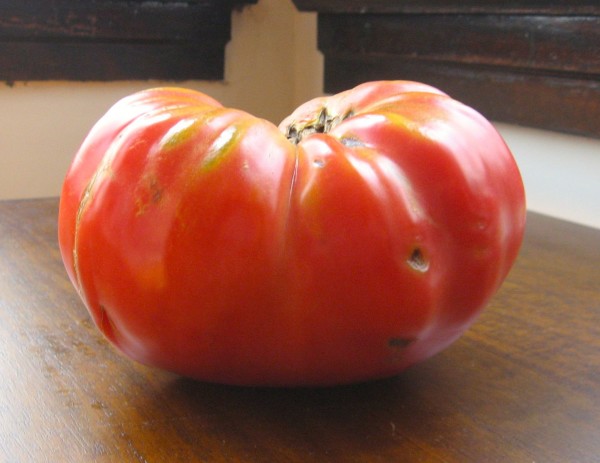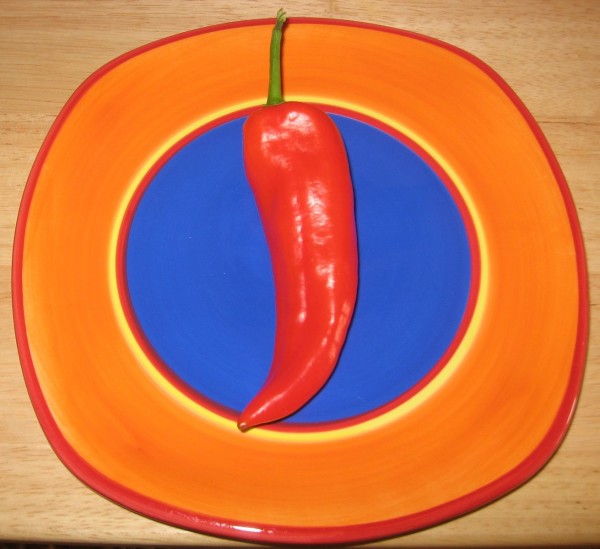For the first time in my life, I rent an apartment with a backyard. This May, I received a wonderful gift of young plants a friend grew on her porch: two kinds of tomatoes—Omar’s Lebanese and Wapsipicon Peach—and a horn-shaped variety of pepper called Carmen.
I’d thought that by mid-July I would be in serious tomato business: canning salsa, simmering sauce, eating homemade pizza sprinkled with sun-warmed tomatoes. But it was a cold spring and summer, and by the end of July, not a single tomato had ripened, and the peppers were tiny. When I left for a two-week vacation in early August, I thought surely the tomatoes would transform from waxy green blobs to burnished red and yellow fruit, so when I asked a friend to look after the garden, I told her she could pick her fill of tomatoes. Alas, they still had not ripened when I returned, though one of the Omar’s Lebanese was so massive it weighed down its branches. “You’d better grab that one before the squirrels do,” my landlady advised. I brought it into the kitchen and tucked it in a brown paper bag until the tomato became a sunset of color.
Finally, by early September, the backyard garden harvest was in full-swing. The Wapsipicon Peach was the real hit: almost as small and bright as a Christmas light, skin as fuzzy as a peach, flavor sweet as any fruit. Not to be outdone, the Omar’s Lebanese grew huge and tasty and obligingly gave up their thin skin when it came time to join the basil in the sauce pot. We have eaten two Carmen peppers, too. One we ate green, and one we let darken to red, and both tasted sweet and spicy, though it reached full flavor once it turned red.
My three plants produced more than my husband and I could eat. I simmered my own tomato sauce, layered a pesto pizza with tomato slices, and discovered this simple, elegant, and mouthwatering tomato pie (or “galette,” if you’re feeling especially refined):
PrintGoat Cheese Tomato Galette
Ingredients
- 1 1/2 cups flour
- 1 stick butter
- 1/3 cup sharp cheddar cheese, shredded
- 4 tablespoons water
- 1/2 teaspoon kosher salt
- 1 egg yolk
- 3 tablespoons bread crumbs
- 2 pounds tomatoes, sliced
- 4 ounces goat cheese, crumbled
- 2 tablespoons olive oil
- 2/3 cup fresh basil, chopped
Instructions
- Preheat oven to 350°F.
- Using a pastry cutter or a fork, mix flour and butter until crumbly. Add cheese, salt and water and blend until the dough just starts to come together. It will still be quite sticky. Form a ball, cover with plastic wrap, and refrigerate for about half an hour. Roll out and transfer to a pie plate.
- Brush egg yolk onto crust, sprinkle bread crumbs on top and arrange tomatoes on top of that. Leave a wide border around the outside.
- Sprinkle goat cheese on top and fold the edges of the pastry over the tomatoes.
- Bake 30-40 minutes, remove from oven, and sprinkle with olive oil and basil.
Unfortunately, all was not joy, bliss and tomato pie forever.
First of all, my landlady was right—squirrels nab tomatoes. I didn’t think squirrels and I could ever be enemies because of how much I respect any animal agile and fearless enough to zoom across a pipe suspended hundreds of feet above a river, and plucky enough to climb a tree with a peanut butter jar in its mouth. Lately, though, I’ve been coming to terms with their dark side. My agile, plucky friends are destructively picky. Like a rich traveler who can’t be bothered to finish a room-service tray, squirrels take three bites of a tomato and then leave it behind. If I didn’t keep after it, the tomato garden would be littered with half-eaten green tomatoes. I really do have to grab any tomato, no matter how green it remains, if it gets big enough to tantalize these rodents (see, they’ve gone from plucky little friends to “rodents”—what does that tell you?).
And then one Saturday, I noticed a more ominous threat. When I started to trim dead leaves from the plants, I realized I was removing more and more brown leaves, and sometimes whole stalks. I’d thought the hot weather had parched a few leaves. When I looked closer, though, it was clear the problem pervaded the plants. Many of the leaves had turned yellow and had black spots. What sort of ailment these tomatoes are suffering from would not be clear without soil samples, or an expert’s eye. It could mean I need to rotate the crop and can’t plant tomatoes for another three years.
As the season closes, I’m still wondering what to do about the soil, hoping next year will bring another blissful harvest, and cheering on the tomatoes that are still ripening this far into September. I’m thankful for a harvest. I’m thinking, too, about farmers, and how much they know, and how well they cultivate, and how hard they work to keep up with nature when it is difficult, and when it is bountiful.





